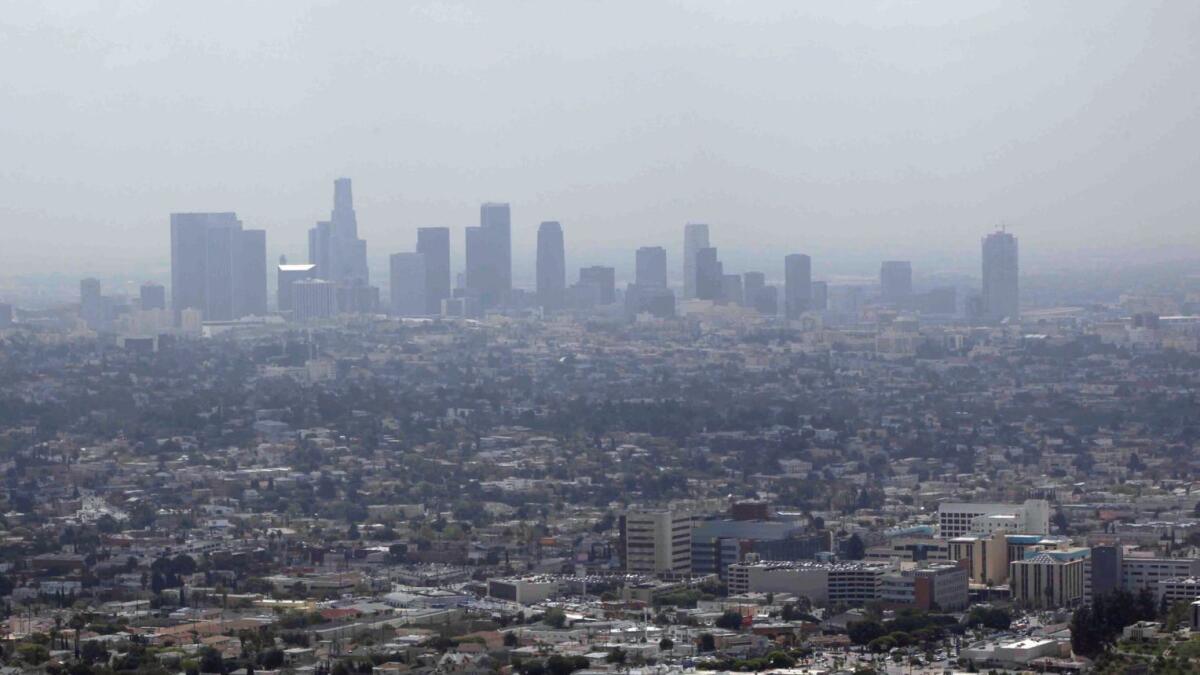Column: The only winners in Trump’s ‘legally indefensible’ attack on California’s emissions rules are the oil companies

The Trump administration will have to go far to outdo, for sheer fatuousness and self-refutation, the excuses it trotted out Thursday for freezing government auto emissions standards and attacking California’s right to set its own rules.
The regulatory proposal unveiled by the Environmental Protection Agency and Department of Transportation had been telegraphed in April. That’s when then-EPA Administrator Scott Pruitt announced his intention to roll back the federal goal of an average vehicular efficiency standard of more than 54.5 mpg by 2025. All that was added on Thursday was a new proposed standard, which is 37 mpg.
Pruitt already had said he was prepared to revoke the waiver, written into the Clean Air Act in the 1970s, allowing California to set its own efficiency standard; the waiver was most recently renewed in 2013 by the Obama administration.
The law is on the side of California and its allies.
— Ann Carlson, UCLA
California officials, including Gov. Jerry Brown, Atty. Gen. Xavier Becerra and Air Resources Board Chairwoman Mary Nichols, said they would fight the revocation, and the betting among legal experts is that the state will win. According to Ann Carlson, an environmental law expert at UCLA, the waiver revocation is “legally indefensible”— in fact, the waiver has been tested several times in federal court and been upheld.
“The law is on the side of California and its allies,” Carlson wrote.
None of the government’s arguments is especially novel. The administration tries to depict its rollback as a blow in favor of safer roads. It comes to this conclusion by arguing that more-fuel-efficient vehicles are more expensive, ergo motorists will hold on to older and less safe vehicles for longer. It says that the fuel-efficient vehicles are lighter, so their drivers and passengers are in greater danger in a collision. And it cites something it calls the “rebound” effect, which is that better fuel efficiency will prompt people to drive more, and that exposes them to more hazards on the road.
The bottom line appears to be that dirtier cars are safer, so let’s keep them dirty. As Kevin Drum observes at Mother Jones, it’s hard to imagine anyone making these arguments with a straight face, but this is the Trump administration.
Even the arguments attached to hard numbers deflate at the merest poke. The proposed regulation cites an economic paper finding that at a price of $36,000 the average new car is unaffordable to median-income buyers in almost every metropolitan area.
But the proposal also acknowledges that the finding was based on the assumption that buyers would post a down payment of 20% and finance the car for four years, and acknowledged that “the market looks nothing like that these days” — it’s not uncommon today for car loans to carry terms of six or seven years, which can cut the monthly payment by more than one-third. As for the $36,000 average price, that’s skewed in the database EPA cites by the cost of SUVs, pickups and luxury cars. The average price of a new midsized car, according to Kelley Blue Book, is less than $26,000.
The administration’s arguments in favor of revoking the waiver allowing the state to set standards for tailpipe emissions of greenhouse gases and on zero-emissions vehicles are especially tortured. The proposal says that the state is out of line in “attempting to solve climate change” through its emissions rules rather than “merely trying to solve its air quality issues.” It says that federal law expressly preempts states, including California, from setting fuel economy standards, and because tailpipe standards “are unquestionably related to fuel economy standards,” California can’t regulate emissions.
That’s cute, but wrong — at least according to three federal court rulings, including one from the Supreme Court. In that case, Carlson observes, the court ruled that the authority to regulate greenhouse gas emissions under the Clean Air Act is “wholly independent” of the Energy Policy and Conservation Act’s ban on state regulation of fuel economy, and therefore isn’t preempted.
The EPA further asserts that the waiver depends on a finding that California needs it to meet “compelling and extraordinary conditions.” The agency argues that the environmental problems the waiver addresses “are not particular or unique to California,… [and] are not caused by emissions or other factors particular or unique to California.”
This doesn’t pass the smell test, even if the smell is strongly redolent of auto exhaust. The EPA proposal itself acknowledges that the state “continues to be in widespread non-attainment with Federal air quality standards.” It’s known that vehicular emissions account for well more than 40% of overall air pollution in the state.
So who are the winners and losers from the administration’s proposed rollback? Although the auto industry has been pushing for a reduction in fuel economy goals for years, this proposal won’t do automakers any favors. The administration’s move only injects uncertainty into emissions rules, given the inevitability of litigation. The industry says that what it really wants is a single nationwide auto emissions standard, but in effect it already has one if it only chooses to comply — California’s, which is followed by 12 other states and the District of Columbia.
Automakers maintain that they don’t have the technology yet to meet the existing rules, and that public resistance to buying smaller, more-fuel-efficient vehicles makes it impossible to meet them on an average fleet basis. Neither argument holds water. The technology exists now to manufacture high-mileage, zero-emissions vehicles, and public sentiment is fickle.
It’s worth remembering that the auto industry maintained for years that the public didn’t want safety enhancements such as seat belts and airbags, so it would be costly to install them. It turned out the manufacturers were blowing smoke: The public cared deeply about safety — and soon enough automakers started using the safety of their vehicles as a selling point.
The public won’t benefit. Even the EPA acknowledges that dirtier air is a threat to health and safety. Simple math shows that motorists will save money by using less fuel — though the EPA claims that people will spend more, because they’ll hold on to their gas guzzlers longer if they can’t afford more-fuel-efficient cars. (Orwell couldn’t have found a better example of black-is-white reasoning if he tried.)
The only winners in this game are oil companies, which will sell more fuel. This was the obvious goal of Pruitt, who was not a regulator, just someone who played one on TV. As he had been as Oklahoma attorney general, he was just a front man for the petroleum industry.
Pruitt is gone now, driven from office by his ethical lapses. But his policies live on, casting a dark shadow over the public interest.
Keep up to date with Michael Hiltzik. Follow @hiltzikm on Twitter, see his Facebook page, or email [email protected].
Return to Michael Hiltzik’s blog.







